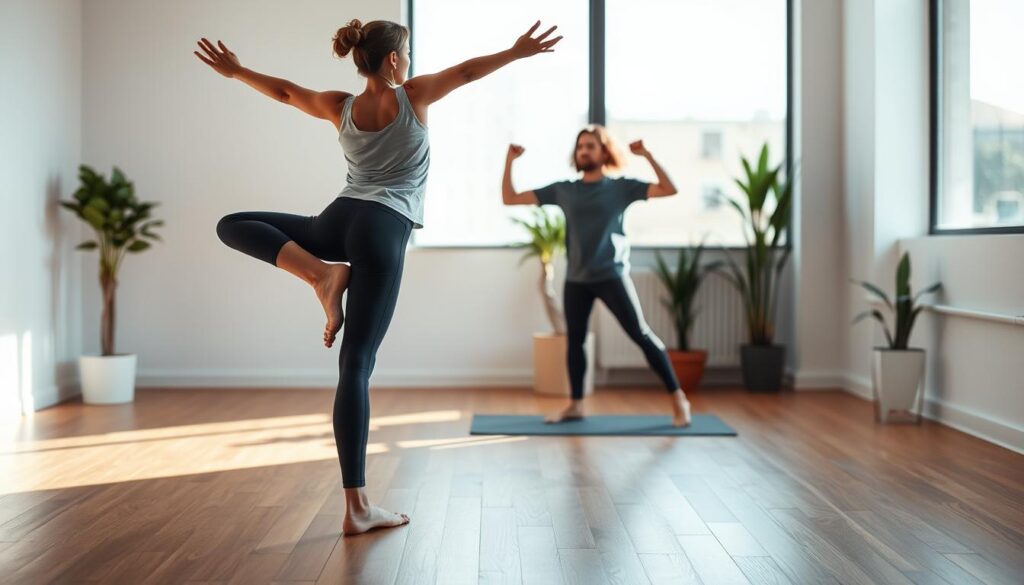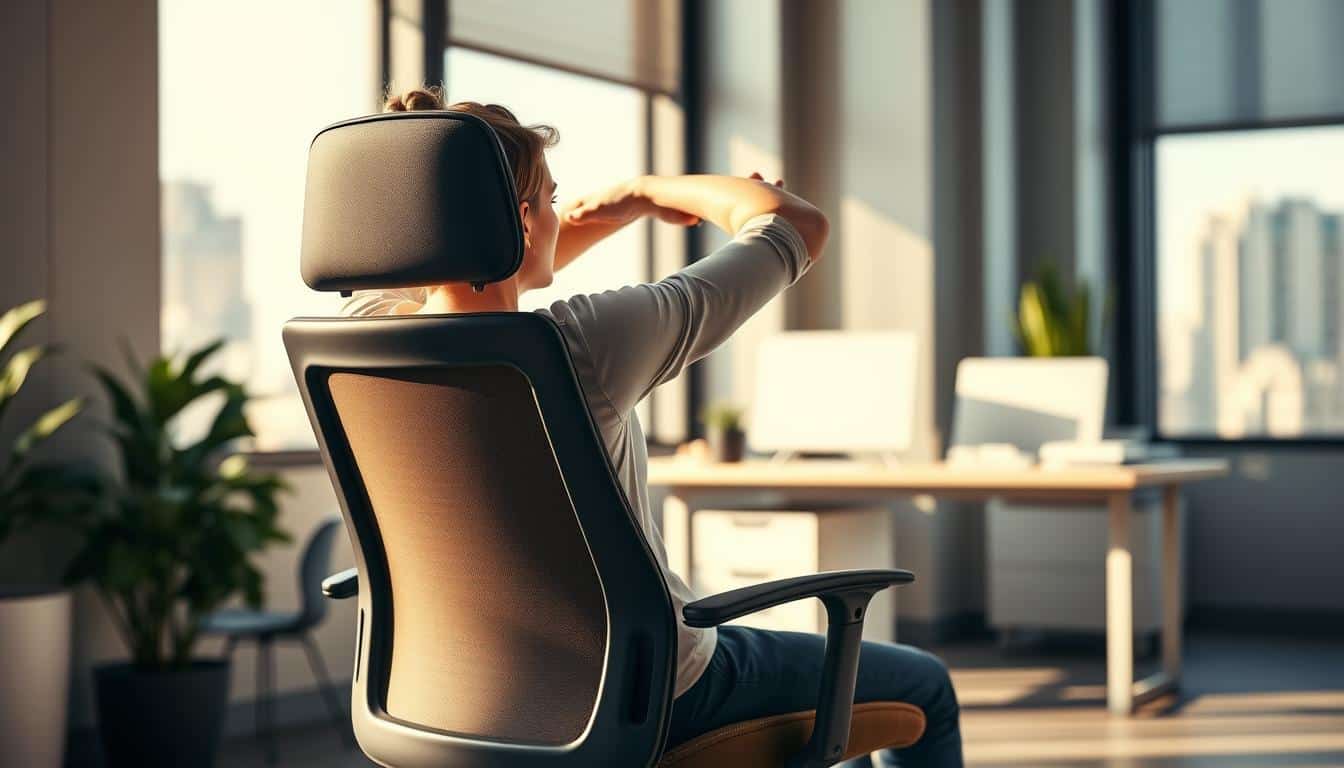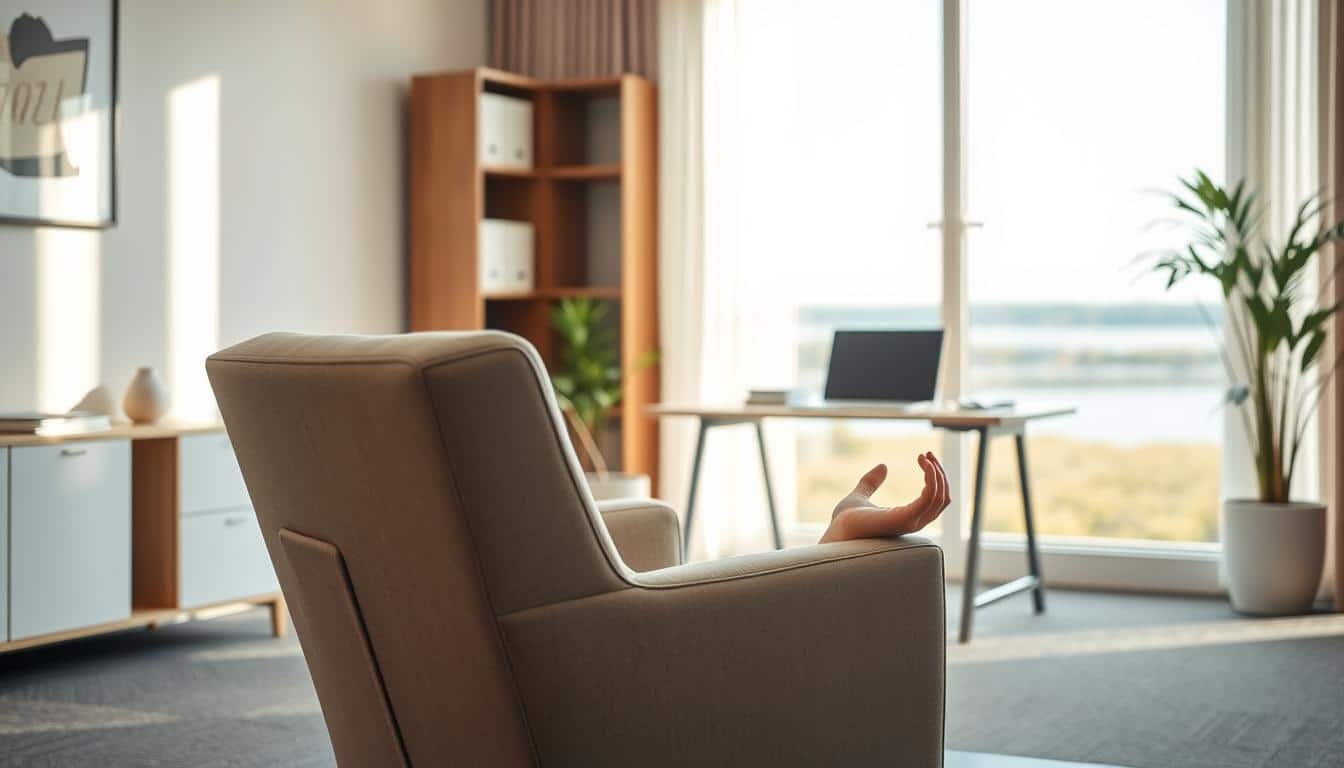In today’s fast-paced work setting, feeling tired and losing focus is common. Office yoga serves a handy way to tackle these problems. It brings a boost of energy and better concentration without much time or tools. With simple yoga poses at work, you can overcome the negatives of sitting too long at a desk. Doing these stretches and moves during your workday can make you feel better and work better.
Quick office yoga routines can ease discomfort and sharpen your focus. They make the workplace more lively. Whether doing seated twists or neck rolls, these simple moves fight stress and spark creativity. Doing them often during your day works best.
Introduction to Office Yoga
Office yoga is great for enhancing workplace wellness. It brings yoga’s stretching and mindfulness right to your desk. This is key for people who sit for long periods each day. Just a quick yoga break can improve their day at work.
Practicing yoga at work has big benefits. It can improve health and make you feel better. Yoga routines are tailored to tackle stress and body stiffness. Starting with breathing exercises helps get your body and mind ready for yoga poses.
Adding yoga to your day can boost focus and creativity. It shows a company cares about its employees’ well-being. Starting office yoga is a step towards a happier, more productive team.
Benefits of Office Yoga
Office yoga has many benefits that can change the vibe at work. It not only keeps you fit but also boosts your well-being. Knowing how it can help may encourage you to start yoga in your daily life.
Enhancing Energy Levels
Office yoga is great for bumping up energy levels. Doing poses like Downward Dog gets your blood flowing better. This means more energy during slow afternoons. Regular yoga keeps employees lively and helps them stay productive all day.
Improving Focus and Concentration
Yoga is amazing for sharpening focus and concentration. Pranayama, or breathing techniques, clears the mind. This helps you stay on task. Studies show that yoga and meditation boost memory and attention span. So, people end up being more productive, creative, and better at solving problems.
Reducing Stress and Anxiety
Office yoga also plays a big part in cutting down stress and anxiety. Breathing methods add to mindfulness, leading to a peaceful work environment. Less stress means employees face challenges with more confidence. Less anxiety not only makes people happier but also helps everyone work together better.
What You Need for Office Yoga
Office yoga needs just a few things. A supportive chair is key for comfy poses. You can stay in your work clothes, as long as they’re loose enough to move in.
Having a book or something flat for adjustments is helpful. It keeps your posture right. Earbuds or headphones let you enjoy calming yoga music.
Make sure your desk area is tidy for easy stretching. You don’t need special gear, just what’s around you. Focusing on comfort and good posture brings out the best in your yoga time.
Office Yoga Poses for Quick Relief
Quick office yoga poses during your workday can ease desk work tension. Doing these desk exercises regularly makes you more comfortable and focused. Here are a few poses that easily fit into your workday.
Seated Twist Pose
This pose releases spine stiffness and boosts flexibility. While sitting, gently twist your body to one side. Hold this for a few breaths, then switch. It eases tension and helps your spine move better.
Shoulder Rolls
Stress often shows up in our shoulders. Do shoulder rolls by lifting your shoulders up and letting them fall back. Doing this a few times eases stress. It’s a simple exercise that improves your posture and feels good.
Wrist and Finger Exercises
Typing and using a mouse can make wrists and fingers sore. Doing wrist circles and finger stretches helps. These quick yoga moves keep your hands working well all day.
Chair Yoga Poses to Try
Chair yoga poses make desk yoga easy with your office chair’s support. They’re good for everyone, letting people add seated stretches to their day. Try these three chair yoga moves to get more flexible and comfy at work.
Seated Figure Four Pose
The seated figure four pose stretches tight outer hips from sitting too long. Sit on your chair’s edge, cross one ankle over the opposite knee, and lean forward a bit. This pose makes you more flexible and helps you relax during busy days.
Seated Crescent Moon Pose
This pose lessens tension in your sides, which is crucial for neck and shoulder health. Sit up straight, stretch one arm over your head, and lean to the side. After holding, switch sides. Such stretches reduce tightness and improve your posture, great for your desk yoga routine.
Seated Back Bend Pose
The seated back bend pose is good for your spine and digestion. Sit well in your chair, place hands on knees, and gently arch your back while lifting your chest. It opens your front body, boosts breathing and focus, and makes work more relaxed.
Standing Yoga Poses for a Midday Boost
Feeling tired in the middle of the day? Try some standing yoga poses. They can help wake up your mind and body. Adding simple exercises at your desk can make you more alert and productive. Try the stork pose and the wide-legged forward bend. They’ll help you stay flexible and think clearly.
Stork Pose
The stork pose focuses on strengthening your lower body and balance. It works your core muscles, improving your coordination. Stand behind your chair and lift one leg behind you, keeping your back straight. This move stretches your hip flexors and quadriceps. It eases tightness and increases motion range.
Wide-Legged Forward Bend
The wide-legged forward bend deeply stretches your back, hamstrings, and hips. It boosts blood flow and circulation. This gives you the energy you need in the middle of the day. Taking time for this exercise will refresh you. You’ll be ready to face the rest of your day.

Integrating Breathwork into Your Office Yoga
Adding breathwork to office yoga makes the whole experience much better. It connects your body and mind closely. By focusing on your breathing, you can concentrate better, even when your office is busy. For example, using Lion’s Breath can energize you and lower stress. It’s great for a boost during the day.
When you control your breathing while doing yoga at your desk, it helps your blood flow better and refreshes your mind. These methods help you work better and stay focused. Starting or ending meetings with a quick breathing or mindfulness exercise can help everyone feel less stressed. This makes the workplace feel calmer and more peaceful.
Using guides or videos on desk yoga and breathing exercises helps everyone learn how to do it. This doesn’t just help each person but also improves the office’s overall mood. Everyone ends up working better and feeling more focused.
How to Create an Office Yoga Routine
To start an office yoga routine, plan it around your work hours. Find specific times during your day for short yoga sessions. Using breaks or time before meetings is perfect for a few minutes of yoga. This helps improve wellness at your work spot.
Finding Time in Your Busy Schedule
Starting a daily yoga doesn’t have to take a lot of time. Choose simple routines that take about five minutes. You can use office furniture to help with your poses, making it easy for everyone. Promoting wellness programs at work helps build a supportive space, encouraging regular health activities.
Doing yoga at the office can increase your energy and make your mind clearer. This helps you focus better. Regular yoga can ease back pain and stiff hips from sitting too much. Try setting reminders to practice yoga every hour or two to better your office well-being.
Conclusion
Office yoga offers a great way to boost energy, focus, and well-being at work. It helps create better health habits among workers. This leads to better posture, more flexibility, and stronger muscles.
Also, yoga at work is key for managing stress. A quick ten-minute yoga session can ease neck and shoulder pain. It helps keep the mind clear, boosts creativity, and makes everyone more productive.
Adding yoga to the workplace shows that a company cares about its employees. This helps keep everyone engaged and satisfied with their jobs. It fights the downsides of sitting all day and keeps teams motivated.



